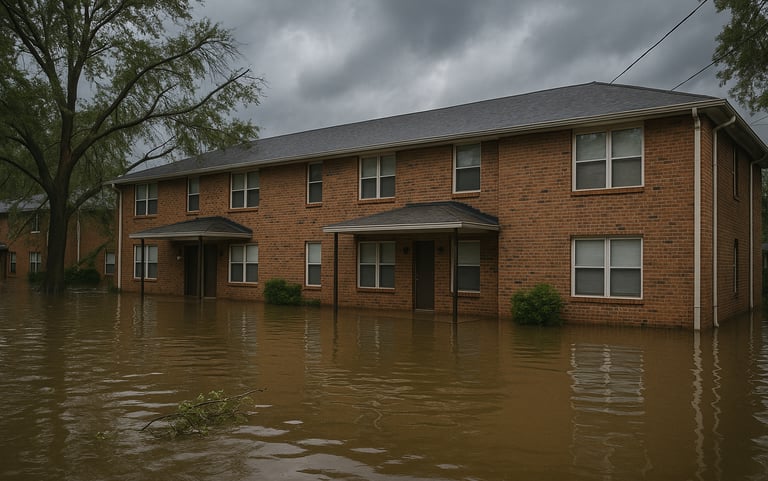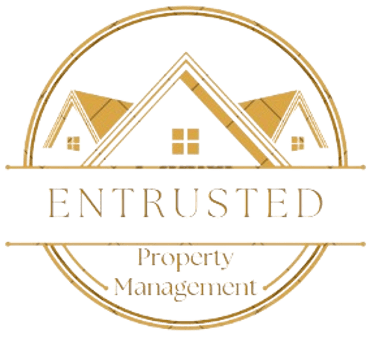When the Unexpected Hits:
Handling Flooding, Storm Damage, and Insurance Claims


Image: ChatGPT.com
As a landlord, one of the biggest challenges isn’t just maintaining properties—it’s managing the unpredictable. Flooding, severe storms, and sudden property damage can strike with little warning, leaving you, your tenants, and your investment vulnerable. Whether you manage a single rental or a full portfolio, having a plan in place before disaster strikes can make all the difference between a quick recovery and a financial nightmare.
1. Prepare Before the Storm
Good property management begins long before the clouds roll in. Start by ensuring that your rental properties are ready for heavy weather:
Inspect drainage systems: Keep gutters, downspouts, and sump pumps clear to prevent backups.
Seal entry points: Check basements, crawl spaces, and foundations for cracks where water could seep in.
Document property condition: Take timestamped photos and videos of the property’s exterior and interior before each storm season—these serve as invaluable evidence during insurance claims.
Landlords should also educate tenants on what to do in the event of flooding or storm warnings—like how to shut off utilities or safely evacuate if necessary.
2. Safety First: Assess and Respond
After a storm, safety takes priority. Never enter a flooded property until professionals have confirmed that power is disconnected and the structure is safe. Communicate clearly with tenants:
Ask if they’re safe and if they’ve experienced damage.
Remind them not to attempt repairs themselves.
Begin documenting everything immediately—photos, videos, and written notes.
If your property management team or vendors are assisting, have them provide written assessments of the damage and repair needs. Keeping an organized record will simplify the claims process later.
3. Understanding Flood and Storm Coverage
Many landlords assume their standard landlord or homeowner’s insurance covers flood damage—but it often does not. Flooding is typically excluded from standard policies and requires separate flood insurance (often through the National Flood Insurance Program, or NFIP).
Key coverage points to review:
Storm and wind damage: Usually covered under standard policies.
Flood damage: Requires separate flood insurance.
Loss of rent: Check if your policy covers rental income lost while repairs are underway.
Tenant belongings: Not covered under your policy—tenants need renter’s insurance.
Pro tip: Review your insurance policies annually, ideally before hurricane or storm season. Update coverage as property values or local risk levels change.
4. Filing an Effective Insurance Claim
The insurance claim process can be tedious—but preparation helps. Here’s how to streamline it:
Contact your insurance company immediately after damage occurs.
Provide documentation: Submit pre- and post-storm photos, contractor estimates, and receipts for emergency repairs.
Avoid early cleanup: Wait until the adjuster inspects, unless cleanup is required to prevent further damage.
Track all communication: Keep a record of emails, phone calls, and claim numbers.
Ask for an advance payment if urgent repairs are needed before your full claim is processed.
Many landlords find it worthwhile to work with a public adjuster—a licensed professional who advocates for property owners and ensures fair claim settlements.
5. Supporting Tenants and Protecting Income
While repairs are underway, tenants may need temporary housing. If your insurance policy covers loss of use or loss of rent, this can offset financial strain. Be transparent with tenants about timelines and progress. If units are uninhabitable, provide clear written notice and options for temporary relocation.
Consider including emergency response clauses in your leases outlining:
Tenant responsibilities (such as immediate reporting of leaks or damage)
Property owner obligations
Procedures for rent adjustment or suspension during major repairs
6. Partnering With Professionals
Effective recovery requires a reliable team:
Restoration contractors: Certified and insured for water and storm damage.
Licensed inspectors: Ensure repairs meet local codes.
Property management experts: Handle logistics, tenant communication, and insurance coordination.
Entrusted Property Management ensures your investment is protected and professionally managed through every phase—from emergency response to long-term maintenance.
Final Thoughts
Storms and floods are unpredictable—but your response doesn’t have to be. By preparing early, maintaining strong documentation, and working with experienced professionals, landlords can turn a potential catastrophe into a controlled recovery.
When the unexpected hits, readiness, organization, and clear communication make all the difference—not only in preserving your property but in maintaining trust and stability with your tenants.
For more information on properties located in Harford & Baltimore County, MD, click here.


